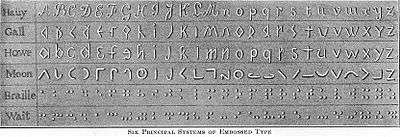Tactile Script

A Tactile Script is a writing system which is not intended for visual interpretation, but is "read" by touch instead. Some can be read by sight, but that is a side effect or unintended consequence of their design; other such scripts may be designed or used in such a way as to force touch-only interpretation. Such scripts can be either alternative alphabets for blind speakers of a language, or be the only alphabet for a language spoken by a culture or species which is blind or puts a low value on the use of sight.
Do not confuse Tactile Scripts with writing systems which transcribe non-oral communication like Telepathy, and which cannot be understood at all by persons or species lacking the relevant means of communication.
Wikipedia, of course, has a small page on the subject.
Compare Alternate Number System.
Tabletop Games
- Dungeons & Dragons
- Illithiad (Monstrous Arcana) introduced Qualith script, made for the illithid way of thinking and hard to understand for creatures that don't have practice with telepathic communication. It usually consists of 4 striated lines that can be followed with tentacles, though certain standalone symbols (Creed identifiers) use 6 lines. They also have the striator - a pen that translates thoughts into this script, even if used by a creature who can't read it.
- Forgotten Realms has an Elven tradition of bidding via yulthaari. It's an IOU note in the form of small platinum tube with "writing" on the inner surface that must be read with one's finger, and as such can't be accidentally read from the outside.
Web Comics
- Schlock Mercenary
- The many-leveled glyphs used by the Oafa includes "touchscript". They are jellyfish-like creatures that resemble a hydrogen blimp with prehensile tentacles dangling from one side.
- The Fobottr have good sense of touch in their big meaty fingers, and use this both for "gripspeak" (silent contact Sign Language) and etched scriptminor spoiler.
Real Life
- The most widely known real-world system is the Braille alphabet for blind people, but there are others, such as Moon code. Several such scripts, including Braille and Moon, can be seen in the image above.
- Ameslan and other Signed Language systems can be used as Tactile Scripts for those who are deaf and blind. The best-known example is probably Helen Keller, as seen in The Miracle Worker.
- Perhaps the most extreme real tactile system is Vibratese, created in 1957. Instead of being based around some manner of alphabet embossed into a surface like Braille, it instead used patterns of vibrations for letters, numerals, and presumably punctuation. It never achieved wide usage, and as of the early 21st century has all but disappeared; there is almost no information left on it.